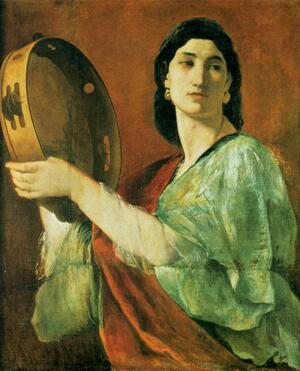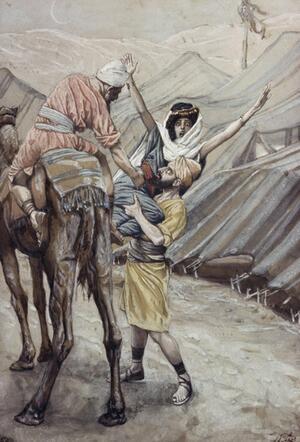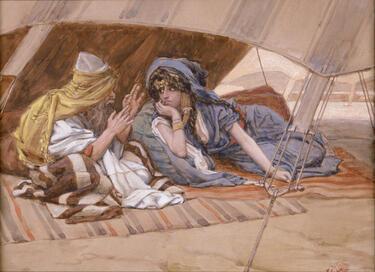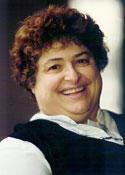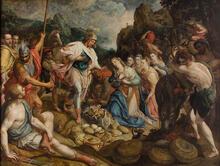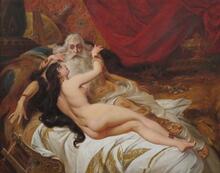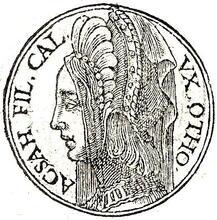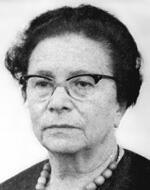Second Temple Reception of Women in Tanakh
The Second Temple period is not a common reference point for many interested in Jewish history, but this 700-800-year span offers the reader a wealth of resources that destabilize assumptions regarding gender in the ancient Mediterranean. This sampling of Second Temple retellings of the Tanakh appear to respond to common questions, concerns, and general curiosity about biblical women in the communities of the writers: Was Dinah innocent or at fault? What was Miriam’s relationship with Moses? Could Sarah really be that deceptive and jealous? In general, Second Temple texts avert attention away from negative or questionable behavior and present biblical women as admirable in their respective contexts.
The Second Temple Period marks the time from the destruction of the first temple in 586/7 BCE to the destruction of the second temple in 70 CE, or until the consolidation of the Codification of basic Jewish Oral Law; edited and arranged by R. Judah ha-Nasi c. 200 C.E.Mishnah (c. 2-3rd centuries CE), depending on the school of thought. A range of resources reflects the dynamic nature of interpretations in this period and offers us a glimpse into the diversity of thought, practice, and culture flourishing within a host of Jewish communities across the Mediterranean and the Near East. Many of these interpretations were not subsequently pursued in rabbinic discourse and were largely lost to Jewish reception history until the discovery of the Dead Sea Scrolls, as well as the reclaiming of texts preserved by Christian sources (i.e. the Apocrypha, Pseudepigrapha, Philo, and Josephus). During the early Second Temple period, the canon was still being codified, and non-canonical texts hold vestiges of circulating traditions that helped communities support different boundary constructions as they processed and shaped their own identities. Second Temple discourse on women and gender is grounded in biblical interpretation and everyday life and, as such, has the potential to shed light on the tumultuous debate between what different communities deemed problematic, acceptable, ideal, and anomalous with respect to a woman’s role in society. A selection of Second Temple texts envisioning Dinah, Miriam, and Sarah indicates these varied perspectives, as well as how these figures were used to promote the ideologies of the particular communities the texts represented.
Dinah
In Genesis 34, Dinah, daughter of Jacob, has an encounter with Shechem, a non-Israelite prince. Genesis is unclear on what transpired, but the standard understanding is that Shechem raped Dinah and then wished above all else to marry her. Jacob agrees to the marriage and the joining of tribes if the Shechemite males undergo circumcision. Dinah’s brothers, Simeon and Levi, feel their sister has been defiled, so they massacre the Shechemites while they are recovering from their circumcisions.
The Book of Jubilees is a retelling of Genesis and the beginning of Exodus, written in Hebrew. Due to the number of Dead Sea Scroll fragment copies dating to the 2nd century BCE and allusions to it in other texts, the book was most likely originally composed in 3rd century BCE and known in a variety of communities. Jubilees strongly advocates for endogamy and integrates additional details about biblical women within its genealogies to promote approved marriages emphasizing the resulting purity of Israel and associating intermarriage with contamination and destruction. Directly after stating that Shechem defiled Dinah, Jubilees adds the detail that she was only twelve years old (Jub. 30:2). Whereas in Gen 49:5-7 Jacob is ashamed of Simeon’s and Levi’s actions and curses their anger, in Jubilees God endorses their actions as righteous violence, written down in a heavenly book as a blessing (Jub. 30:6, 30:23). Because circumcision is non-negotiable and intermarriage anathema in Jubilees, the text omits Shechemite circumcision (Gen 34:24) because it would cause undue complications for strict views on exogamy to present a story in which the “outsider” was willing to make such a sacrifice. By removing the morally questionable setting behind Dinah’s brothers’ actions, Jubilees promotes an ideology invested in a presentation of the “outsider” as a clear and viable threat and intermarriage as an act of defilement. Boundaries with the “other” are more easily promoted when the “us”-and-“them” construct allows for no openings for reconciliation, compromise, or compassion. Jubilees presents Dinah as the symbol of virtue and emblematic of Israel’s virgins, who have been violated and therefore must be avenged. Jubilees supports Dinah’s innocence and does not imply that she was complicit in her defilement, an implication found in some later interpretations grounded in victim-blaming that disparage Dinah for “going out” (Gen. Rab. 18:12; Avot de-Rabbi Nathan, version B, chap. 3; Tg. Job).
The philosopher Philo of Alexandria (c. 15 BCE – c. 45 CE) re-envisions the Dinah account in De migratione Abrahami 39.221-25 and De mutatione nominum 36.193-200. All characters are allegorized and Dinah becomes the embodiment of incorruptible judgment, the tribunal of the soul, justice (Migr.39:223; Mut.36:194), and a virgin soul (Migr. 39:224; Mut.36:194). Philo’s allegorical retelling identifies Hamor as a name that translates to “ass,” representing folly and shamelessness, and his son Shechem’s name as meaning “shoulder,” representing toil and the irrational (Migr. 39:224; Mut. 36:193). Genesis 34 now describes how the irrational (Shechem) “attempted to pollute and to defile” incorruptible judgment or the soul (Dinah). This irrational attempt to pollute judgment is thwarted and destroyed by Simeon and Levi, who represent “pupils and friends of wisdom” (Migr. 39:224; Mut. 36:200). Dinah as the soul is redeemed through her brothers’ actions, but Philo clarifies that since she was not at fault she was never defiled: “the soul, which before appeared defiled, changes and returns to its virgin state. I say, which appeared to be defiled, because, in fact, it never was defiled; for of involuntary accidents that which affects the patient is not in reality his suffering” (Migr. 39:225). Mut. 36:193-200 focuses on Shechem as a deceiver who speaks of fairness and prudence in order to disguise impurity and profanity. Philo consistently smooths over any biblical narratives that can be read as morally questionable, so like Jubilees, he eliminates the circumcision debate. Philo typically allegorizes the rational soul and positive characteristics as masculine and irrational or negative attributes as feminine, but Dinah is given an honored position as embodied judgment, justice, and the soul whose resilience and innocence ultimately make her untouchable by the irrational and deceptive.
In Antiquitates judaicae, the historian Flavius Josephus (c. 37 CE-c.100 CE) presents Dinah as Jacob’s only daughter, who went to the city during a festival in order to see the adornments of the Shechemite women (A.J. 1.337-342). As in Genesis, Hamor asks Jacob for Dinah’s hand on his son’s behalf. Here, Shechem’s status as a foreigner was not automatically enough for him to be dismissed, as it was in Jubilees. Jacob acknowledges Shechem’s rank and is confused about how to proceed. Diverging from Genesis, which keeps this decision between himself and his sons, Josephus has Jacob hold a council to debate the problem, but the majority remains silent, except for Simeon and Levi. That night, without Jacob’s consent, the brothers kill all the male Shechemites. When Jacob finds out, he is dismayed at the excessive violence, and God tells him to take courage and purify his tents. Josephus also omits the circumcision debate, but he retains Jacob’s critique of Simeon’s and Levi’s zeal and ends the narrative abruptly. It is noteworthy that Josephus recounts the story of Dinah, since he omits other biblical narratives that could be viewed as problematic, such as the Golden Calf episode in Exodus and the story of Judah and Tamar in Genesis. Although Dinah herself is given little individual attention, Josephus’s silence preserves Dinah as the blameless victim and highlights her as a cherished commodity as Jacob’s only daughter.
Dinah is briefly also mentioned as a blameless victim who was righteously avenged in the apocryphal text of Judith 9:2, the pseudepigraphal texts of the Testament of Levi 5:3, and Joseph and Aseneth 23:14, all of which present her brothers’ vengeance as sanctioned by God and their weapons divinely blessed. Pseudo-Philo offers a two-line account that Dinah’s brothers enact righteous justice against Shechem’s assault of their sister, and adds that Dinah is later married to Job, which means that Dinah was not viewed as defiled and unmarriable (L.A.B. 8:7-8; this is also found in the Testament of Job 1:6).
Dinah thus serves multiple purposes in Second Temple texts. She serves as a conduit for articulating firm boundary markers in Jubilees, provides a feminine aspect to incorruptible judgment or the soul in Philo, becomes a valuable member of the household protected by overzealous brothers in Josephus, and proves to be the blameless victim worthy of God’s vengeance in a number of additional texts. These retellings remove the moral ambiguity of Genesis and present Dinah clearly as a victim and the Shechemites as predators. Dinah is not stigmatized and remains a consistent symbol of resilience and innocence.
Miriam
Exodus, Numbers, and 1 Chronicles discuss the figure of Miriam, who has been understood to be the sister of Moses and Aaron and is described as a prophet.
Second Temple texts offer a fuller image of Miriam in the cultural imagination of Jewish communities. Miriam in the Dead Sea Scroll text, Reworked Pentateuch [4Q365 6a II + 6c, 1-7), preserves an extended song of Miriam (Exod 15:21), similar to the victory song of Judith (Jdt 16:1-17) and Deborah (Judges 5:5). While Exodus 2:4 (the story of Moses’s birth and adoption by Pharaoh’s daughter) does not name Moses’s sister, Jubilees names Miriam in retelling the story and elaborates that she watched over Moses while in the basket to protect him from being attacked by birds (Jub 47:4). A second century BCE writer named Ezekiel wrote a dramatic play of the Exodus narrative called the Exagoge in the style of a Greek tragedy. In Exagoge, Ezekiel follows Jubilees by naming Miriam and presenting her as staying close to Moses to protect him (v.18-31). Jubilees does not mention Miriam outside of this account, which is striking since Jubilees often clarifies full genealogies and marriages. Jubilees might avoid focusing on Miriam’s genealogy because her parents, Jochebad and Amram, were an aunt/nephew relationship (Num 26:59), which Jubilees prohibited even though uncle/niece relationships were encouraged (Halpern-Amaru, 123).
By contrast, the Dead Sea Scroll text Visions of Amram (VA) [4Q543-549] promotes endogamy and endorses both uncle/niece and aunt/nephew relationships as ideal, so it did not avoid Jochebad and Miriam’s genealogy. Indeed, it elaborated that, at 30 years old, Miriam married her father’s younger brother Uzziel, because such unions showcased the Levite family’s commitment to endogamy and sanctity of the priestly line. Miriam is also depicted as having visions and as the only woman in the Dead Sea Scrolls connected with “raz” or a “secret/mystery,” which is associated with esoteric knowledge. Miriam’s “raz” supports her prophetic role mentioned in Exodus 15:20 (Tervanotko, 145).
Philo discusses Miriam five times in three different works: De vita contemplativa 87, De agricultura 80-81, and Legum allegoriae 1.76, 2.66-7, and 3.103. In Contempl. 87, Philo expands on Exod 15:20 and refers to Miriam as a prophetess who leads the female chorus in hymns to God, while Moses leads the men. Philo returns to this imagery in Agr. 80-81, where he allegorizes Moses as the Mind, leading the choir of men in perfection, and Miriam as sense-perception made pure, leading the choir of women. The choirs work in unison as mind and the senses/body are led in praise of the divine. In Leg. 1.76, 2.66-7, and 3.103, Philo engages with Miriam’s punishment in Numbers 12 for speaking up against and challenging Moses. Philo often allegorizes conflicts to make sense of them, so Miriam becomes the allegorical representation of the shameless and bold/foolish nature of sense perception that is sometimes in conflict with the Mind. Philo thus presents both positive and negative portrayals of Miriam depending on her attitude or role with respect to Moses.
Pseudo-Philo’s Liber antiquitatum biblicarum (L.A.B.), a first century CE retelling of biblical history, develops Miriam’s prophetic role by expanding on Exodus 2 to include that Miriam has a dream from God that foretells the birth of her brother Moses, declaring that he would be cast into the water, part the sea, and save God’s people (L.A.B 9:9-10). Miriam’s parents do not believe her. L.A.B. 20:8 states that God gave three gifts to the people of Israel on behalf of Moses, Aaron, and Miriam and when each of them died their gifts were taken away: for Moses the manna, for Aaron the pillar of the cloud, and for Miriam the well of the water of Marah. These gifts place Miriam’s leadership on equal status with her two brothers.
In Josephus’s retelling of Exodus 2, Miriam’s mother asks her to watch where the basket holding Moses goes, and Miriam later suggests to the Egyptian princess that a Hebrew woman could nurse the infant. In A.J. 3.54, Josephus states that Miriam was married to Hur/Ouros, who fought the Amalekites alongside Moses and Aaron (Exod 17:8-12). This is the only attestation of Miriam as married to Hur, which Josephus mentions again in A.J. 3.105, where Miriam is referred to as the sister of the general (Moses) and grandmother of Bezalel (1 Chr 2:19-20). A.J. 4.78 states that Miriam died 40 years after the Exodus, that she was given a lavish burial, and that the people mourned for 30 days and were then purified by Moses. This elaborate response to Miriam’s death reflects her honored place among the Israelite people.
In an in-depth analysis of Miriam in Second Temple texts, Tervanotko convincingly argues that Miriam was a well-respected figure with a developed tradition that extended well beyond her portrayal in the Hebrew Bible, a reputation upon which authors drew to support and promote the Levite family in the Hellenistic period, but then later waned by the Roman period when she was relegated to her role as subordinate to Moses (Tervanotko, 180-193, 285-294). As demonstrated above, there was a concerted effort in Second Temple texts to align Miriam more closely with Moses, presenting her as her brother’s protector and omitting or de-emphasizing their disputes, thus acknowledging her authority as a necessary gender counter-balance to Moses.
Sarah
Genesis introduces the matriarch of Israel, Sarah, the wife of Abraham and the mother of Isaac.
A variety of Second Temple texts highlight Sarah as the mother of the elect, royalty, and embodied virtue while de-emphasizing, omitting, or justifying any negative characteristics such as jealousy. Philo clarifies that allegorically matriarchs and helpmates of the patriarchs are actually virtues, of which Sarah is the sovereign leader (Cher. 41; Her. 258). He presents the name change (Gen 17:15) from Sarai (personal sovereignty) to Sarah (general sovereign) as a shift from specific or individualistic virtues, which are perishable, to generic virtues which are imperishable (Cher. 3-8; Mut. 61, 77-78. 130; Abr. 99; Congr. 1-3). Philo’s allegorical reading lifts Sarah up as the ideal of virtue and wisdom, an elevated position typically reserved for the masculine, but permitted because he sees Sarah as ceasing the ways of women (presumably having gone through menopause) and thus transcending the limitations of the feminine (Gen 18:11; Cher. 41-50; Her. 62).
Philo reflects discomfort with Abraham’s apparent abandonment of Sarah (QG 4.60-1), so in his literal exegesis he omits the Abimelech episode and Abraham’s request for Sarah to say she is his sister (Gen 20:2-5). He retains the Pharaoh incident (Abr. 89-98) but, by presenting both Abraham and Sarah praying for divine protection, he insists that Abraham was not at fault (Abraham also prays for help in Gen. Apoc. 20:12-16). He gives Sarah an extensive obituary in which she is presented as a virtuous wife and lifelong partner to Abraham, who, devastated at the thought of losing her, recounts how she has followed him without complaint through difficult journeys and would selflessly do anything for his betterment (Abr. 245-54). Philo enhances scenes from Genesis to demonstrate that Sarah’s prayers were answered and that God was interested in her wellbeing (Abr. 90-98, 107-113). Sarah is presented as rational and logical by offering Hagar to Abraham as a solution to her barrenness and stating that she would adopt any resulting offspring (Abr. 248-50; Leg. 3.244-45). Philo omits Sarah’s jealousy (Gen 16:6; 21:10), as does Jubilees. Unlike Gen 18:1-15, where Sarah is relegated to preparing food, Philo has Sarah and Abraham receive the promise together and respond to the visitors at Mamre together with disbelief. Sarah’s laughter prompts the visitors to ask, “Is anything impossible for God?” and she realizes they are divine messengers (Abr. 111-113) while Abraham did not notice (Abr. 107). Similarly, it is Sarah who notices that the archangel Michael is visiting them in the Testament of Abraham, while Abraham is unaware (Test. Abr. 6).
Josephus typically minimizes presentations of Sarah in Genesis as an active agent. For example, in his telling, God commands that Hagar be brought to Abraham to conceive children, not Sarah (Gen 12:2; A.J. 1.187). Josephus does not mention Sarah at the Mamre visitation (Gen 18:6; A.J. 1.197), yet he adds to his Aqedah that Abraham hid his plans from Sarah and the servants because he was afraid they would stop him, even though Sarah is not mentioned in Gen 22 (A.J. 1.225). Concerning the Pharaoh incident, Sarah is presented as protected by God. She is not at fault; rather it is the Pharaoh and the Egyptians who are unable to control themselves when encountering beauty, thus their criminal passion is at fault (A.J. 1.162-165, B.J. 5.379-381). Josephus states that when Sarah died, the Canaanites offered her burial at public expense, but Abraham bought a burial spot where he and his descendants also built their tombs (A.J. 1.237). Tervanotko and Uusimäki argue that Josephus’s added detail that Sarah was offered a funeral at public expense indicates that she had a public and popular reputation beyond the private, domestic space (Tervanotko & Uusimäki, 284-5). Josephus’s representation of Sarah and Dinah reflect a similar focus on male predatory behavior and the innocence of the female object of desire. Likewise, Sarah’s funeral as a public event is reminiscent of Miriam’s funeral, both of which reflect Josephus’s acknowledgment of the important role each woman played in Jewish history.
This is only a small sampling of Second Temple retellings of the Tanakh that appear to respond to common questions, concerns, and general curiosity about biblical women in the communities of the writers: Was Dinah innocent or at fault? What was Miriam’s relationship with Moses? Could Sarah really be that deceptive and jealous? In general, Second Temple texts avert attention away from negative or questionable behavior and present biblical women as admirable in their respective contexts. This period also prominently features women as either primary protagonists, such as Judith, Esther, Aseneth, and Susanna, reflecting an increased interest in female representation in Jewish writings. This tendency is not restricted to Jewish writings but reflects a wider trend in the Mediterranean during this period, which is most likely linked to the presence of strong queens across the empires of the time, including the Maccabean Queen Shelamziyyon Alexandra who ruled from 76-67 BCE. The Second Temple period is not a common reference point for many interested in Jewish history, but this 700- 800-year span offers the reader a wealth of resources that destabilize assumptions regarding gender in the ancient Mediterranean.
Bader, Mary Anna, Tracing the Evidence: Dinah in Post-Hebrew Bible Literature. New York: Peter Lang Pub., 2008.
Brown, Cheryl Anne No Longer Be Silent: First Century Jewish Portraits of Biblical Women. Louisville, KY: Westminster/John Knox Press, 1992.
Feldman, Louis H. "Philo, Pseudo-Philo, Josephus, and Theodotus on the Rape of Dinah." The Jewish Quarterly Review 94, no. 2 (2004): 253-277.
Halpern-Amaru, Betsy, The Empowerment of Women in the Book of Jubilees. Leiden: Brill, 1999.
Levine, Amy-Jill ed.“Women Like This” New Perspectives on Jewish Women in the Greco-Roman World. Atlanta: Scholars Press, 1991.
Niehoff, Maren. “Mother and Maiden, Sister and Spouse: Sarah in Philonic Midrash” Harvard Theological Review 97, no. 4 (2004): 413-444.
Rothstein, David. “Text and Context: Domestic Harmony and the Depiction of Hagar in Jubilees” Journal for the Study of the Pseudepigrapha 17, no.4 (2008): 243-264.
Schuller, E. “Women of the Exodus in Biblical Retellings of the Second Temple Period.” In Gender and Difference in Ancient Israel, edited by P. Day, 178–94. Minneapolis, MN: Fortress, 1989.
Tervanotko, Hanna. Denying Her Voice: The Figure of Miriam in Ancient Jewish Literature. Göttingen: Vandenhoeck & Ruprecht, 2016.
Tervanotko, Hanna & Elisa Uusimäki, “Sarah the Princess: Tracing the Hellenistic Afterlife of a Pentateuchal Female Figure” Scandinavian Journal of the Old Testament 32, no. 2 (2018): 271-290.

